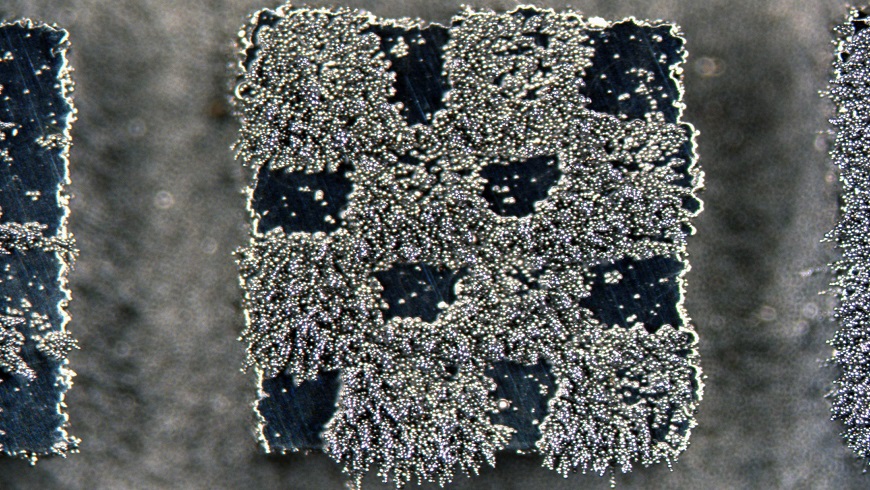Researchers at the Swiss Federal Laboratories for Materials Science and Technology (EMPA) have 3D printed a partially magnetic metal structure, using only a single type of steel powder, by changing its properties.
Described as a “small metallic chessboard”, the piece is composed of 16 squares, 8 of which are magnetic, and the others non-magnetic. 3D printed using a laser powder bed fusion (LPBF) technique from a single grade of metal powder, the differing properties were created only by varying the power and duration of the laser, while making use of LPBF’s high temperatures.
The ability to produce different alloy compositions with micrometer precision in a single component could potentially prove useful to the methodology of metal production and processing. “In 3D laser printing, we can easily reach temperatures of more than 2500 degrees Celsius locally,” explains Christian Leinenbach, who led the EMPA project. “This allows us to vaporize various components of an alloy in a targeted manner – e.g. manganese, aluminum, zinc, carbon and many more – and thus locally change the chemical composition of the alloy.”

3D printing different alloy compositions with micrometer precision
Metal LPBF 3D printing, in particular Direct Metal Laser Sintering (DMLS) or Selective Laser Melting (SLM), has particular advantages in fabricating strong parts with complex geometries, while reducing the cost of material and time.
However, there are some significant disadvantages to the manufacturing technique. During the LPBF process, temperatures of more than 2,500 degrees Celsius are reached within milliseconds, causing some components of the alloy material powder to evaporate.
The EMPA researchers, Aryan Arabi-Hashemi and Leinenbach, set out to demonstrate how this apparent drawback can be leveraged to benefit the production process. The research team illustrates this using a special type of stainless steel, which was developed some 20 years ago by the company Hempel Special Metals in Dübendorf, among others.
Known as P2000 steel, the metal does not contain nickel, but around one percent of nitrogen. Additionally, P2000 does not cause allergies and is well suited for medical applications as well. Unfortunately, at first glance it also seems unsuitable as a base material for LPBF 3D printing: in the melting zone of the laser beam, the temperature quickly peaks. This causes a large part of the nitrogen within the metal to evaporate, forcing the properties of the P2000 steel to change.

However, Arabi-Hashemi and Leinenbach modified the scanning speed and the intensity of the laser beam, which melts the particles in the metal powder bed, and thus altered the size and lifetime of the liquid melt pool in a particular manner. In the smallest case, the pool was 200 microns in diameter and 50 microns deep, in the largest case 350 microns wide and 200 microns deep.
A larger melt pool allows much more nitrogen to evaporate from the alloy; the solidifying steel crystallizes with a high proportion of magnetizable ferrite. With the smallest melt pool, the melted steel solidifies much faster. The nitrogen remains in the alloy; the steel crystallizes mainly in the form of non-magnetic austenite. As they performed the experiment, the researchers had to determine the nitrogen content in millimeter-sized metal samples very precisely and measure the local magnetization to within a few micrometers, as well as the volume ratio of austenitic and ferritic steel. This helped to embed the 3D printed metallic workpiece with novel magnetic properties using micrometer precision.
Producing different alloy compositions with micrometer precision in a single component can potentially enable the design of more efficient electric motors. It is now possible to build the stator and the rotor of the electric motor from magnetically finely structured materials, which can help to make better use of the geometry of the magnetic fields.
Advancing LPBF 3D printing
The LPBF process overall is seeing continuous development recently, as different organizations seek to develop and advance the technology.
Earlier in 2020 global standards developer ASTM International announced that the F42 additive manufacturing technologies committee was developing a standard for the LPBF 3D printing process.
In January this year, French industrial 3D printer provider AddUp also entered into a $2.7 million cooperative research and development agreement (CRADA) with the Oak Ridge National Laboratory (ORNL), to develop metal additive manufacturing materials processes for tooling. In particular the partners have opted to focus on advancing LPBF technology for novel metal molds used in tooling.
The nominations for the 2020 3D Printing Industry Awards are now open. Who do you think should make the shortlists for this year’s show? Have your say now.
Subscribe to the 3D Printing Industry newsletter for the latest news in additive manufacturing. You can also stay connected by following us on Twitter and liking us on Facebook.
Looking for a career in additive manufacturing? Visit 3D Printing Jobs for a selection of roles in the industry.

